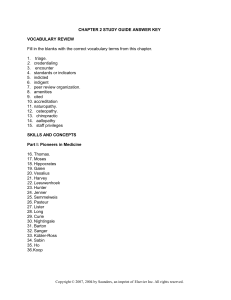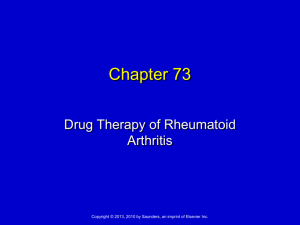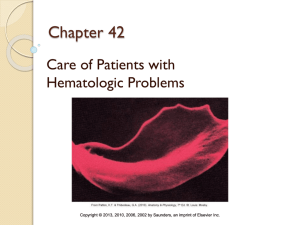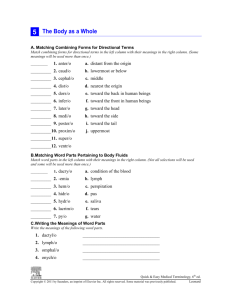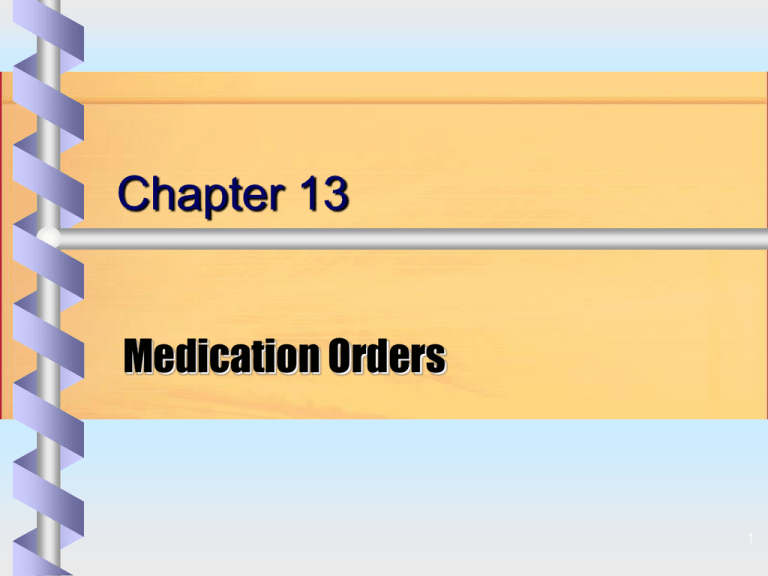
Chapter 13
Medication Orders
1
Objectives
• Explain the benefits of Computer Physician
Order Entry regarding medication orders.
• Define standing, standing prn, stat, one-time,
and short-series medication orders.
• List the five components of a medication order.
Copyright © 2009, 2004 by Saunders, an imprint of Elsevier Inc. All rights reserved.
Slide 2
Objectives, continued
• List four groups of drugs that usually have
automatic “stop dates.”
• Name two reference books for
medications.
• List four routes by which medications are
administered.
Copyright © 2009, 2004 by Saunders, an imprint of Elsevier Inc. All rights reserved.
Slide 3
Objectives, continued
• Demonstrate the procedure for using the
Physicians’ Desk Reference (PDR).
• Describe the general purpose for selected drug
groups.
• Name three common skin tests performed and
explain the purpose of each.
Copyright © 2009, 2004 by Saunders, an imprint of Elsevier Inc. All rights reserved.
Slide 4
Objectives, continued
• Recognize the most commonly used drugs,
which are listed in italics in the “Drug Groups”
section of the chapter, and name the drug group
to which each belongs.
Copyright © 2009, 2004 by Saunders, an imprint of Elsevier Inc. All rights reserved.
Slide 5
Lesson 13.1
Copyright © 2009, 2004 by Saunders, an imprint of Elsevier Inc. All rights reserved.
Slide 6
Adverse Drug Events (ADEs)
770,000 people are injured or die annually as a
result of ADEs
• 56% occurred at the stage of ordering
• 34% at administration
• 6% at transcribing
• 4% at dispensing
Copyright © 2009, 2004 by Saunders, an imprint of Elsevier Inc. All rights reserved.
Slide 7
Computer Physician Order Entry (CPOE) &
Clinical Decision Support System (CDSS)
• Medications are ordered automatically when
CPOE is implemented
• Orders are sent directly to the pharmacy
• Handwriting errors are reduced and fewer
adverse drug events occur
• Orders are integrated with patient information,
allergies, lab results, and prescription data when
used with a Clinical Decision Support System
(CDSS)
• Physicians are warned against drug
interactions, allergies, or overdose
Copyright © 2009, 2004 by Saunders, an imprint of Elsevier Inc. All rights reserved.
Slide 8
Medical Administration Record (MAR):
Computerized or Handwritten
• Medication orders are printed or written on
the MAR
• The MAR is a permanent part of the
patient’s chart
Copyright © 2009, 2004 by Saunders, an imprint of Elsevier Inc. All rights reserved.
Slide 9
Medication Names
• Official name: name under which drug is listed in
official government publications of drug standards
• Chemical name: name that describes the chemical
composition of the drug
• Generic name: shortened name given to the drug
by the developer; generic names are not capitalized
Copyright © 2009, 2004 by Saunders, an imprint of Elsevier Inc. All rights reserved.
Slide 10
Medication Names, continued
• Brand name, trade name, or proprietary name:
name given to and registered by the
manufacturer
The brand name is always capitalized and
may have a trademark symbol (™ or ®)
A drug has only one generic name but may
have many trade names, depending on how
many companies manufacture it
Copyright © 2009, 2004 by Saunders, an imprint of Elsevier Inc. All rights reserved.
Slide 11
5 Components of a Medication Order
1. Name of medication
2. Dose
3. Route
4. Frequency
5. Qualifying phrase
Example:
Demerol 100 mg IM q 4 hrs for pain
(1)
(2) (3) (4)
(5)
Copyright © 2009, 2004 by Saunders, an imprint of Elsevier Inc. All rights reserved.
Slide 12
Medication Forms
Copyright © 2009, 2004 by Saunders, an imprint of Elsevier Inc. All rights reserved.
Slide 13
Medication Doses
• Apothecary system
• Metric system
Copyright © 2009, 2004 by Saunders, an imprint of Elsevier Inc. All rights reserved.
Slide 14
Apothecary System
• Grain
• Dram
• Ounce
gr
dr or
or
• Measurements in this system are written in
lower case Roman numerals. These numerals
have a line over them and may be dotted to
avoid confusion with similar-appearing letters
or numerals
Copyright © 2009, 2004 by Saunders, an imprint of Elsevier Inc. All rights reserved.
Slide 15
Metric System
• Weight
• Volume
• Length
gram (g)
liter (L)
meter (M)
• Smaller and larger units in the metric system
can be indicated by attaching prefixes to the
basic units
Kilo- is used to enlarge the basic unit 1000
times
Copyright © 2009, 2004 by Saunders, an imprint of Elsevier Inc. All rights reserved.
Slide 16
Metric System, continued
• centi (cm) is used to diminish the basic unit by
100
• milli (mm), (mL), and (mg) diminishes the basic
unit by 1000
• The symbol µ micro (micrometer or 0.001
millimeter)
• The terms milliliter (ML) and cubic centimeter
(CC) are used interchangeably
Copyright © 2009, 2004 by Saunders, an imprint of Elsevier Inc. All rights reserved.
Slide 17
Metric System, continued
• The metric system uses the Arabic numerals
that we all know, e.g., 1, 2, 3
• Abbreviations are placed after the number, as
in 50 mg or 500 mL
• Quantities less than 1 and fractions are written
in decimal form as in 0.25 mg, 1.25 mg, and
1.5 g
Copyright © 2009, 2004 by Saunders, an imprint of Elsevier Inc. All rights reserved.
Slide 18
Routes for Administering Medication
• PO
• Sub-ling - SL
• Topical
• Inhalants
Oral
Under the tongue
Sprays, creams,
suppositories
Nebulizers
Copyright © 2009, 2004 by Saunders, an imprint of Elsevier Inc. All rights reserved.
Slide 19
Routes for Administering Medication,
continued
Parenteral:
Intramuscular (IM)
Intravenous (IV)
Subcutaneous (SQ)
Intradermal (ID)
Transdermal
Copyright © 2009, 2004 by Saunders, an imprint of Elsevier Inc. All rights reserved.
Slide 20
Angle of Needle Insertion for Parenteral
Injections
From Potter PA, Perry AG: Fundamentals of Nursing, 6th ed, St. Louis, Mosby, 2005.
Copyright © 2009, 2004 by Saunders, an imprint of Elsevier Inc. All rights reserved.
Slide 21
To Reduce Needle Sticks: A Syringe with
Needleless Adapter and Sharps Disposal
From Potter PA, Perry AG: Fundamentals of Nursing, 6th ed, St.
Louis, Mosby, 2005.
Copyright © 2009, 2004 by Saunders, an imprint of Elsevier Inc. All rights reserved.
Slide 22
Three Components of an IV Order
• Amount
• Solution
• Rate
Examples:
Amt
Sol
Rate
1000cc D5LR TRA 120cc/hr
or
Amt
Sol
Rate
1000cc 0.45 NS TKO
Copyright © 2009, 2004 by Saunders, an imprint of Elsevier Inc. All rights reserved.
Slide 23
IV Push and IV Bolus
• IV Push: method of giving concentrated doses of
medication directly into the vein
• IV Bolus: concentrated dose of medication or fluid,
frequently given intravenously
Copyright © 2009, 2004 by Saunders, an imprint of Elsevier Inc. All rights reserved.
Slide 24
Admixture
• The result of adding a medication to a
container of intravenous fluid
Copyright © 2009, 2004 by Saunders, an imprint of Elsevier Inc. All rights reserved.
Slide 25
Intravenous Piggyback (IVPB)
• Medication is added to 50-100 cc of
fluid in a small bag and connected to
port in main IV tubing
Copyright © 2009, 2004 by Saunders, an imprint of Elsevier Inc. All rights reserved.
Slide 26
Frequency of Administration
• Each hospital maintains a schedule of hours for
administration of medications that is set up by
the hospital nursing service
• You are required to learn the hours that are
standard for your hospital
• Note: Standard prn orders are never assigned a
time, because the drugs are administered as
they are needed by the patient
Copyright © 2009, 2004 by Saunders, an imprint of Elsevier Inc. All rights reserved.
Slide 27
Qualifying Phrases
• When a doctor wishes a drug to be
administered only for specific conditions, a
qualifying phrase will be part of the medication
order
• Not all orders contain qualifying phrases
• Examples of commonly used phrases:
For severe pain
For stomach spasms
For N/V
While awake
For insomnia
Copyright © 2009, 2004 by Saunders, an imprint of Elsevier Inc. All rights reserved.
Slide 28
5 Rights of Medication Administration
•
•
•
•
•
Right drug
Right dose
Right time
Right route
Right patient
Copyright © 2009, 2004 by Saunders, an imprint of Elsevier Inc. All rights reserved.
Slide 29
The Joint Commission’s (TJC’s) “Do Not
Use” Abbreviation List
Courtesy of The Joint
Commission May 2005
Copyright © 2009, 2004 by Saunders, an imprint of Elsevier Inc. All rights reserved.
Slide 30
Categories of Medication Orders
• Standing
Example: Synthroid 0.1mg po qd
• Standing PRN
Example: Tylenol i or ii po q 4 hr for H/A
• Short-series order
Example: Prednisone 5 mg po tid x 3 days,
then 5 mg bid x 2 days then 5 mg qd x 5 days
Copyright © 2009, 2004 by Saunders, an imprint of Elsevier Inc. All rights reserved.
Slide 31
Categories of Medication Orders,
continued
• One time
Example: Demerol 50 mg IM @ 0800 in am
• Stat
Example: Valium 5 mg IV now
Copyright © 2009, 2004 by Saunders, an imprint of Elsevier Inc. All rights reserved.
Slide 32
Controlled Substances
• Schedule I - This group has a high potential for
abuse and is usually nonexistent in a health care
setting except for specific, approved research
Examples: heroin and marijuana
• Schedule II - This group has a high potential for
abuse and may lead to severe physical or
psychological dependence
Examples: Demerol, morphine, codeine
Copyright © 2009, 2004 by Saunders, an imprint of Elsevier Inc. All rights reserved.
Slide 33
Controlled Substances, continued
• Schedule III - There is moderate or low potential
for abuse in this group
Examples: Tylenol with codeine, Phenaphen
with codeine, Doriden, and Fiorinal
• Schedule IV - The potential for abuse is lower in
this class than for drugs in schedule III
Examples: Talwin, Valium, and meprobamate
Copyright © 2009, 2004 by Saunders, an imprint of Elsevier Inc. All rights reserved.
Slide 34
Controlled Substances, continued
• Schedule V - The abuse potential of these drugs
is limited
Examples: Actifed with codeine, Lomotil,
Phenergan with codeine, and Triaminic with
codeine
Copyright © 2009, 2004 by Saunders, an imprint of Elsevier Inc. All rights reserved.
Slide 35
Medications that Have Stop Dates
• 3 days
Narcotics
Analgesics with narcotics
Hypnotics
• 10 days
Antibiotics
Anticoagulants
• Stop dates vary from hospital to hospital
Copyright © 2009, 2004 by Saunders, an imprint of Elsevier Inc. All rights reserved.
Slide 36
Renew Medication Stamp
Date
Time
00/00/00 0900
Symbol
M
Doctor, the ___________
Has Expired.
Do you wish the ________
Renewed? Yes __ No __
Dr. Signature: _________
Copyright © 2009, 2004 by Saunders, an imprint of Elsevier Inc. All rights reserved.
Slide 37
Lesson 13.2
Copyright © 2009, 2004 by Saunders, an imprint of Elsevier Inc. All rights reserved.
Slide 38
Drug Groups
•
•
•
•
•
•
•
•
•
•
Drugs that affect the nervous system
Drugs that affect the respiratory system
Drugs that treat infections: antiinfective drugs
Drugs that affect the endocrine system
Drugs that affect the cardiovascular system
Drugs that affect the gastrointestinal system
Drugs that affect the musculoskeletal system
Antineoplastics
Vitamins
Topical preparations
Copyright © 2009, 2004 by Saunders, an imprint of Elsevier Inc. All rights reserved.
Slide 39
Drugs that Affect the Nervous System
•
•
•
•
•
•
•
•
Narcotics
Analgesics with narcotics
Analgesics (nonnarcotic)
Patient-controlled analgesia
Sedatives/hypnotics
Antianxiety drugs
Antidepression drugs
Anticonvulsants
Copyright © 2009, 2004 by Saunders, an imprint of Elsevier Inc. All rights reserved.
Slide 40
Narcotics
•
•
•
•
Codeine
Meperidine hydrochloride (Demerol)
Oxycodone (OxyContin)
Morphine sulfate
Copyright © 2009, 2004 by Saunders, an imprint of Elsevier Inc. All rights reserved.
Slide 41
Analgesics with Narcotics
•
•
•
•
Aspirin #1, 2, 3, or 4
Percocet
Percodan
Acetaminophen (Tylenol) #1, 2, 3 or 4
Copyright © 2009, 2004 by Saunders, an imprint of Elsevier Inc. All rights reserved.
Slide 42
Analgesics (Nonnarcotic)
• Acetylsalicylic acid (aspirin)
• Ibuprofen (Motrin)
• Acetaminophen (Tylenol)
Copyright © 2009, 2004 by Saunders, an imprint of Elsevier Inc. All rights reserved.
Slide 43
Sedatives/Hypnotics
• Zolpidem (Ambien)
• Flurazepam (Dalmane)
• Temazepam (Restoril)
Copyright © 2009, 2004 by Saunders, an imprint of Elsevier Inc. All rights reserved.
Slide 44
Antianxiety Drugs
• Lorazepam (Ativan)
• Diazepam (Valium)
• Alprazolam (Xanax)
Copyright © 2009, 2004 by Saunders, an imprint of Elsevier Inc. All rights reserved.
Slide 45
Antidepression Drugs
• Amitriptyline (Elavil)
• Fluoxetine (Prozac)
• Sertraline (Zoloft)
Copyright © 2009, 2004 by Saunders, an imprint of Elsevier Inc. All rights reserved.
Slide 46
Anticonvulsants
• Phenytoin (Dilantin)
• Luminal (Phenobarbital)
• Gabapentin (Neurontin)
Copyright © 2009, 2004 by Saunders, an imprint of Elsevier Inc. All rights reserved.
Slide 47
Drugs that Affect the Respiratory System
•
•
•
•
•
Antihistamines
Nasal decongestants
Antitussives
Expectorants
Drugs used to treat asthma and related
conditions
Copyright © 2009, 2004 by Saunders, an imprint of Elsevier Inc. All rights reserved.
Slide 48
Antihistamines
• Desloratadine (Clarinex)
• Fexofenadine (Allegra)
• Benadryl
Copyright © 2009, 2004 by Saunders, an imprint of Elsevier Inc. All rights reserved.
Slide 49
Drugs Used to Treat Asthma and Related
Conditions
•
•
•
•
•
Aminophylline
Fluticasone (Advair)
Albuterol (Proventil, Ventolin)
Theophylline (Theo-Dur)
Montelukast (Singulair)
Copyright © 2009, 2004 by Saunders, an imprint of Elsevier Inc. All rights reserved.
Slide 50
Drugs that Treat Infections: Antiinfective
Drugs
• Antibiotics
• Antifungals
• Antivirals
Copyright © 2009, 2004 by Saunders, an imprint of Elsevier Inc. All rights reserved.
Slide 51
Antibiotics
•
•
•
•
•
•
•
•
•
Amoxicillin
Azithromycin (Zithromax)
Cephalexin (Keftab)
Ciprofloxacin (Cipro)
Penicillin (Pen Vee K)
Clindamycin (Cleocin)
Doxycycline (Vibramycin)
Vancomycin
Gentamicin
Copyright © 2009, 2004 by Saunders, an imprint of Elsevier Inc. All rights reserved.
Slide 52
Antifungals
• Amphotericin B (Amphotec)
• Fluconazole (Diflucan)
• Nystatin (Mycostatin)
Copyright © 2009, 2004 by Saunders, an imprint of Elsevier Inc. All rights reserved.
Slide 53
Antivirals
• Acyclovir (Zovirax)
• Ribavirin (Virazole)
• Zidovudine (Relenza)
Copyright © 2009, 2004 by Saunders, an imprint of Elsevier Inc. All rights reserved.
Slide 54
Drugs that Affect the Endocrine System
• Antidiabetics
• Hormones
Copyright © 2009, 2004 by Saunders, an imprint of Elsevier Inc. All rights reserved.
Slide 55
Antidiabetics
• Oral:
Glipizide (Glucotrol)
Metformin (Glucophage)
• Subcutaneous insulin:
Insulin glargine (Lantus)
Insulin lispro (Humalog)
NPH (pork NPH Iletin II, Humulin N)
Insulin, regular
Copyright © 2009, 2004 by Saunders, an imprint of Elsevier Inc. All rights reserved.
Slide 56
Hormones
•
•
•
•
•
•
•
Medroxyprogesterone (Depo-Provera)
Hydrocortisone (Solu-Cortef)
Prednisone (Deltasone)
Estrogen (Premarin)
Progesterone (Progestin)
Levothyroxine (Synthroid)
Testosterone (Andronaq, Histerone)
Copyright © 2009, 2004 by Saunders, an imprint of Elsevier Inc. All rights reserved.
Slide 57
Drugs that Affect the Cardiovascular
System
•
•
•
•
•
•
•
Antidysrhythmic agents
Antianginal agents
Antihypertensive agents
Diuretic agents
Potassium replacements
Antilipidemics
Anticoagulants
Copyright © 2009, 2004 by Saunders, an imprint of Elsevier Inc. All rights reserved.
Slide 58
Antiarrhythmic Agents
• Diltiazem (Cardizem)
• Digoxin (Lanoxin)
• Lidocaine (Xylocaine)
Copyright © 2009, 2004 by Saunders, an imprint of Elsevier Inc. All rights reserved.
Slide 59
Antianginal Agents
•
•
•
•
Nitroglycerin (Nitro-Bid)
Isosorbide (Isordil)
Nifedipine (Procardia)
Metoprolol (Lopressor)
Copyright © 2009, 2004 by Saunders, an imprint of Elsevier Inc. All rights reserved.
Slide 60
Antihypertensive Agents
•
•
•
•
•
•
Carvediol (Coreg)
Atenolol (Tenormin)
Fosinopril (Monopril)
Enalapril (Vasotec)
Apresoline (hydralazine)
Sodium nitroprusside (Nipride), (most commonly
used to manage a hypertensive crisis)
Copyright © 2009, 2004 by Saunders, an imprint of Elsevier Inc. All rights reserved.
Slide 61
Diuretic Agents
• Hydrochlorothiazide (HydroDIURIL)
• Furosemide (Lasix)
Copyright © 2009, 2004 by Saunders, an imprint of Elsevier Inc. All rights reserved.
Slide 62
Potassium Replacements
• Potassium chloride (Kaochlor, K-Lor,
Micro K, Slow-K, K-Lyte)
Copyright © 2009, 2004 by Saunders, an imprint of Elsevier Inc. All rights reserved.
Slide 63
Antihyperlipidemics
•
•
•
•
•
Gemfibrozil (Lopid)
Fenofibrate (Tricor)
Atorvastatin (Lipitor)
Lovastatin (Mevacor)
Simvastatin (Zocor)
Copyright © 2009, 2004 by Saunders, an imprint of Elsevier Inc. All rights reserved.
Slide 64
Anticoagulants
•
•
•
•
Warfarin (Coumadin)
Heparin (Hepaliean)
Enoxaparin (Lovenox)
Clopidegrel (Plavix)
Copyright © 2009, 2004 by Saunders, an imprint of Elsevier Inc. All rights reserved.
Slide 65
Drugs that Affect the Gastrointestinal
System
• Antacids, antisecretory, and antiulcer drugs
• Antidiarrheals and laxatives
• Antiemetics and antinausea drugs
Copyright © 2009, 2004 by Saunders, an imprint of Elsevier Inc. All rights reserved.
Slide 66
Antacids, Antisecretory, and Antiulcer
Drugs
•
•
•
•
•
•
•
Maalox
Mylanta
Pepto-Bismol
Ranitidine (Zantac)
Famotidine (Pepcid)
Cimetidine (Tagamet)
Omeprazole (Prilosec)
Copyright © 2009, 2004 by Saunders, an imprint of Elsevier Inc. All rights reserved.
Slide 67
Antidiarrheals and Laxatives
Antidiarrheals
• Kaopectate
• Loperamide
(Imodium)
• Diphenoxylate
(Lomotil)
Laxatives
• Psyllium (Metamucil)
• Bisacodyl (Dulcolax)
• Polyethylene glycol
(GoLYTELY)
• Phosphates (Fleets oral or
enema preparation)
• Magnesium citrate
Copyright © 2009, 2004 by Saunders, an imprint of Elsevier Inc. All rights reserved.
Slide 68
Antiemetics/Antinauseants
• Prochlorperazine (Compazine)
• Hydroxyzine (Vistaril)
Copyright © 2009, 2004 by Saunders, an imprint of Elsevier Inc. All rights reserved.
Slide 69
Drugs that Affect the Musculoskeletal
System
• Antiinflammatory drugs
Steroids
NSAIDs
• Muscle relaxants
Copyright © 2009, 2004 by Saunders, an imprint of Elsevier Inc. All rights reserved.
Slide 70
Antiinflammatory Drugs
Steroids
• Hydrocortisone
(Cort-Dome,
Hytone)
• Prednisone
(Deltasone)
NSAIDs
• Naproxen (Anaprox,
Naprosyn)
• Sulindac (Clinoril)
• Prioxicam (Feldene)
• Ibuprofen (Motrin)
Copyright © 2009, 2004 by Saunders, an imprint of Elsevier Inc. All rights reserved.
Slide 71
Muscle Relaxants
• Cyclobenzaprine (Flexeril)
• Carisoprodol (Soma)
• Orphenadrine citrate (Norflex)
Copyright © 2009, 2004 by Saunders, an imprint of Elsevier Inc. All rights reserved.
Slide 72
Antineoplastics
•
•
•
•
•
•
•
Cisplatin (Platinol–AQ)
Cyclophosphamide (Cytoxan)
Doxorubicin (Adriamycin)
Interferon alfa (Intron A)
Methotrexate (Folex, Mexate)
Tamoxifen (Tamofen)
Vincristine (Oncovin)
Copyright © 2009, 2004 by Saunders, an imprint of Elsevier Inc. All rights reserved.
Slide 73
Vitamins
• Phytonadione – vitamin K (AquaMEPHYTON)
• Multivitamin (MVI)
• Cyanocobalamin – vitamin B12
Copyright © 2009, 2004 by Saunders, an imprint of Elsevier Inc. All rights reserved.
Slide 74
Topical Preparations
• Ophthalmic preparations (eye)
Bacitracin c polymyxin B (Polysporin ophthalmic ointment and suspension)
Bacitracin c polymyxin B and neomycin (Neosporin
ophthalmic - ointment and solution)
Timolol (Timoptic ophthalmic solution)
• Otic preparations (ear)
Hydrocortisone c ciprofloxacin
Vosol HC otic solution
Copyright © 2009, 2004 by Saunders, an imprint of Elsevier Inc. All rights reserved.
Slide 75
Topical Preparations, continued
• Preparations for the skin
Betadine spray
Hydrocortisone
Neosporin ointment
Copyright © 2009, 2004 by Saunders, an imprint of Elsevier Inc. All rights reserved.
Slide 76
Reagents Used for Diagnostic Tests
Doctors’ orders for skin tests:
• PPD today: screening test for tuberculosis
• Cocci 1:100 now: diagnostic test for
coccidioidomycosis (valley fever)
• Histoplasmin 0.1 mL today: aids in diagnosing
histoplasmosis, a fungal disease
Copyright © 2009, 2004 by Saunders, an imprint of Elsevier Inc. All rights reserved.
Slide 77
Medication Stock Supply
• Hospitals store a supply of medications on
nursing units
• When floor stock medicines are ordered from the
pharmacy, they are charged to the unit budget
Copyright © 2009, 2004 by Saunders, an imprint of Elsevier Inc. All rights reserved.
Slide 78
Medication Carts
From Lilley LL, Aucker RS: Pharmacology and the Nursing
Process, ed 3, St. Louis, 2001, Mosby.
Copyright © 2009, 2004 by Saunders, an imprint of Elsevier Inc. All rights reserved.
Slide 79
Discontinuing Medication Orders
• When a doctor discontinues a standing or
standing prn order, he or she indicates this by
writing an order on the doctors’ order sheet.
Example:
DC Achromycin 500 mg PO tid
Copyright © 2009, 2004 by Saunders, an imprint of Elsevier Inc. All rights reserved.
Slide 80
Medication Order Changes
• Medication orders may need to be changed for
various reasons
• The change may involve the dosage, route of
administration, or frequency of a drug already
ordered
• Whenever a change is made, it is considered a
new order and should be written as such on the
medication administration record
Copyright © 2009, 2004 by Saunders, an imprint of Elsevier Inc. All rights reserved.
Slide 81
Medication Order Changes, continued
Examples:
Change Demerol 50 mg IM q 4h prn to Demerol
50 mg PO q 4h prn (change in route of
administration)
Decrease ampicillin 500 mg PO qid to 250 mg PO
qid (change in dosage)
Change Librium 5 mg PO tid to 5 mg PO qid
(change in frequency of administration)
Copyright © 2009, 2004 by Saunders, an imprint of Elsevier Inc. All rights reserved.
Slide 82





